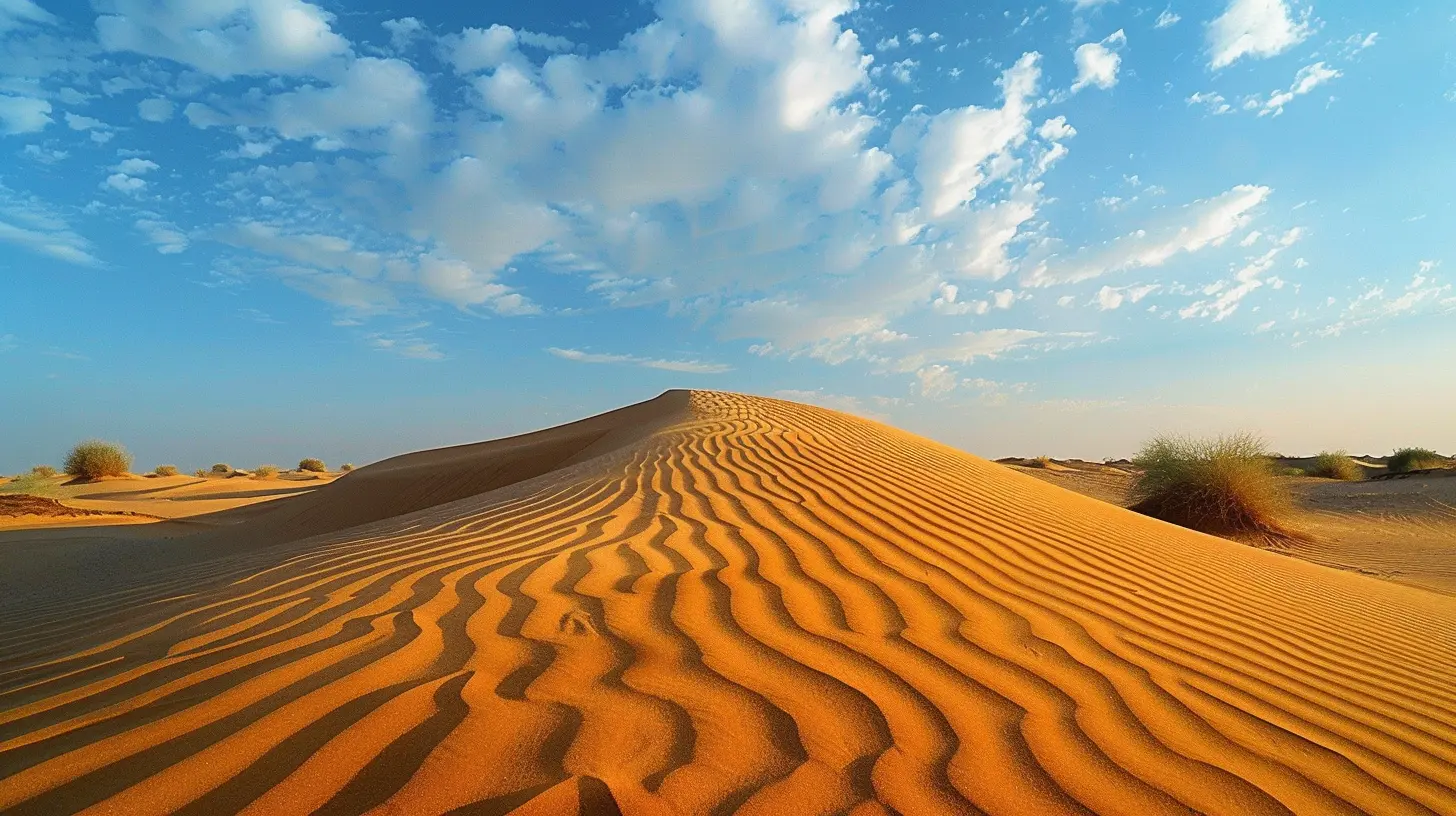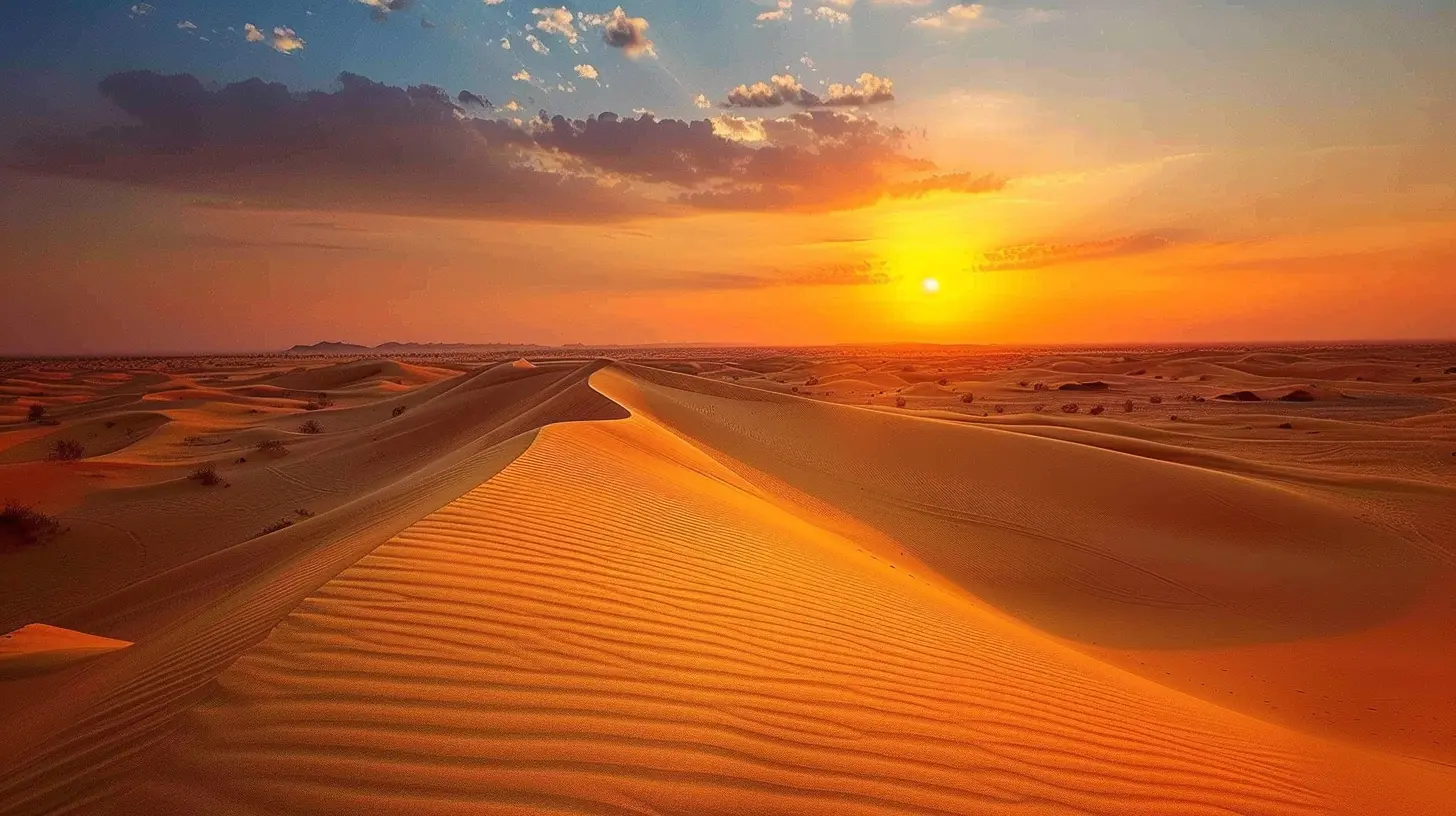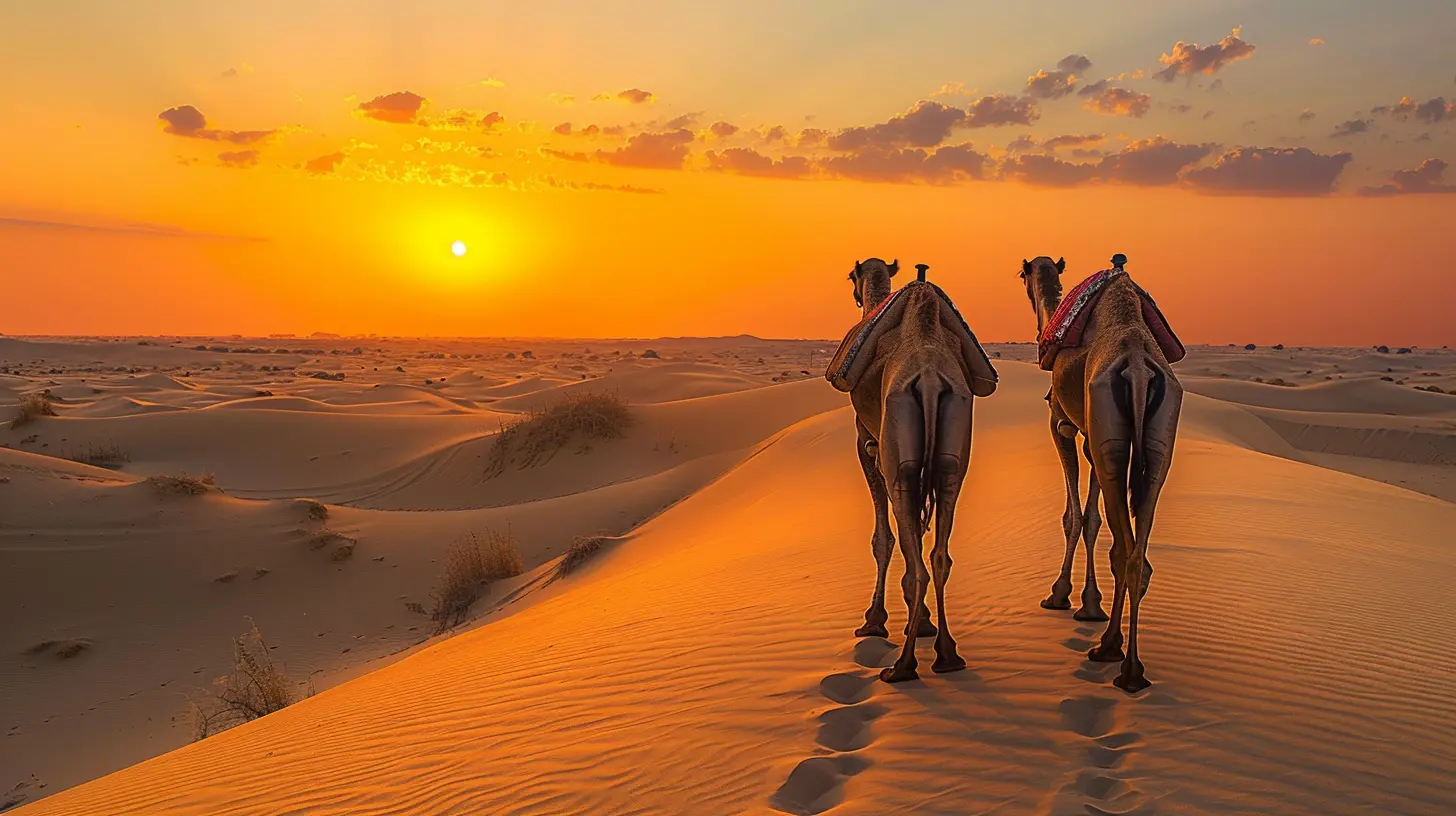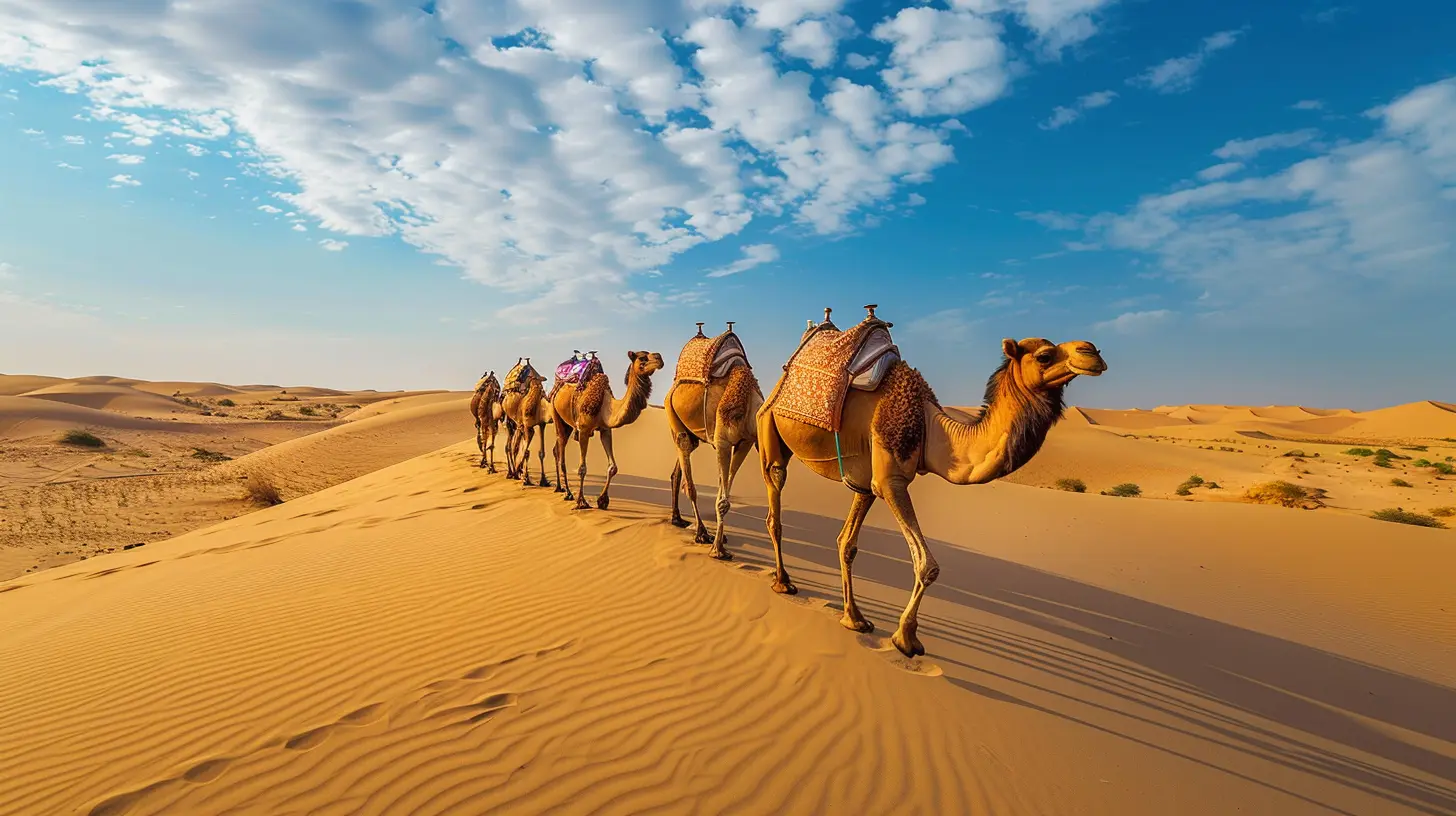The Golden Sands of the Thar Desert: Rajasthan’s Frontier
3 June 2025
Rajasthan, the land of kings, is a mesmerizing blend of history, culture, and natural beauty. But if there's one place that truly encapsulates the rugged spirit of this Indian state, it's the Thar Desert. Stretching across Rajasthan’s western frontier, the Thar Desert—also known as the Great Indian Desert—is a vast expanse of golden sand dunes, resilient life, and endless adventure.
This is not just a barren wasteland; it’s a living, breathing spectacle of history and culture. From vibrant desert festivals to the enduring legacy of the Rajput warriors, the Thar is where the past whispers through the sands. Let’s take a deep dive into what makes this region so special. 
The Enchanting Landscape of the Thar Desert
Picture this: golden dunes shifting under endless blue skies, camels gently plodding along as nomadic tribes move from one oasis to another. The Thar is an ocean of sand, shaped by the winds and kissed by the sun.Despite its arid nature, the Thar is teeming with life. Acacia trees, khejri, and desert shrubs dot the landscape, providing much-needed shade and sustenance for creatures that have adapted to its harsh environment. The region is home to the elusive Indian gazelle (chinkara), desert fox, and the great Indian bustard—a critically endangered bird that finds refuge in these sands. 
Jaisalmer: The Golden City in the Heart of the Thar
If there’s one city that epitomizes the charm of the desert, it’s Jaisalmer. Often called the "Golden City," Jaisalmer rises like a mirage on the horizon, its sandstone architecture glowing under the relentless sun.Jaisalmer Fort: A Living Legacy
Unlike most forts in India, Jaisalmer Fort isn’t just a historic monument—it’s alive. Within its walls, generations of families continue to live, running shops, cafes, and guesthouses. Walking through its narrow lanes feels like stepping back in time, with echoes of Rajasthani folk music and the aroma of local delicacies filling the air.Sam Sand Dunes: A Desert Safari Dream
For those wanting to experience the desert at its rawest, the Sam Sand Dunes are the place to go. A camel safari at sunset is an experience that’s nothing short of magical. The sand turns golden, shifting with the wind as you ride through the dunes, taking in the vastness of the desert. And when night falls? The sky explodes into a canvas of stars, clearer than you’ve ever seen before.
The Culture and Traditions of the Thar
One of the most fascinating aspects of the Thar Desert is its rich cultural heritage. The people here, despite the challenges of the harsh climate, have crafted a lifestyle that thrives in harmony with the land.The Nomadic Tribes and Their Way of Life
The Bhils, Rabaris, and Bishnois are some of the indigenous communities of the Thar who have preserved their ancient traditions for centuries. From their colorful turbans and ghagras to their unique dialects and music, their culture is as vibrant as the desert itself.These tribes are masters of the desert. They know which plants can be used for medicine, how to find water in the driest months, and how to read the shifting sands like a book. Many still practice traditional occupations like camel herding, weaving, and pottery, keeping their ancestral wisdom alive.
Folk Music and Dance: The Soul of Rajasthan
No visit to Rajasthan is complete without experiencing its electrifying folk performances. The Thar’s music tells tales of love, war, and devotion through instruments like the sarangi, dholak, and algoza.- The Kalbeliya dance, performed by snake charmers, is an intense, hypnotic display of movement.
- The Ghoomar dance, once performed by royal Rajput ladies, is a captivating swirl of colors and rhythm.
- The Manganiyar musicians can make a single note feel like poetry, singing centuries-old tales passed down through generations.
At night, around a flickering fire under the open sky, these performances make the desert come alive in ways that words cannot describe. 
Iconic Festivals of the Thar Desert
If you want to witness Rajasthan’s culture at its liveliest, time your visit to coincide with one of its grand desert festivals.The Jaisalmer Desert Festival
Held in February, this festival is Rajasthan at its most extravagant. Imagine camels racing across golden dunes, turban-tying competitions, puppet shows, and dazzling folk performances. The festival honors Rajasthan’s warrior spirit and artistic heritage, culminating in a spectacular night of music and fireworks under the desert sky.Pushkar Camel Fair
Though more famous for its religious significance, the Pushkar Camel Fair is also a massive cultural gathering. Thousands of camels, horses, and traders descend upon the desert town of Pushkar, creating a carnival-like atmosphere with competitions, acrobatics, and traditional crafts.The Mystique of Rajasthan’s Haunted Desert
While the Thar Desert is known for its beauty and culture, it also holds its fair share of mysteries.Kuldhara: The Ghost Village
Just outside Jaisalmer lies Kuldhara, an abandoned village that locals swear is haunted. Once home to the prosperous Paliwal Brahmins, the entire village mysteriously vanished overnight about 200 years ago. Rumors say a cruel ruler forced them to flee, leaving behind a ghost town that still carries an eerie silence.The Bhangarh Fort Legends
Though technically not in the Thar, Bhangarh Fort is one of Rajasthan’s most notorious haunted spots. According to legend, a sorcerer cursed the town, causing its eventual destruction. Even today, entry is prohibited after sunset, as locals claim to hear whispers and see ghostly figures among the ruins.Desert Cuisine: A Flavorful Surprise
You might think that food in the desert would be plain and simple. Think again! The Thar Desert has some of the most flavor-packed dishes in Rajasthan.- Dal Baati Churma – The iconic trio of lentils, baked wheat dumplings, and sweetened wheat crumbs.
- Ker Sangri – A tangy, spicy dish made from dried desert beans and berries.
- Gatte ki Sabzi – Gram flour dumplings cooked in a rich, yogurt-based gravy.
- Laal Maas – A fiery red mutton curry that’s not for the faint-hearted!
Because of the scarcity of water, dried ingredients and milk-based dishes dominate Rajasthani cuisine, making it a unique blend of resourcefulness and indulgence.
Best Time to Visit the Thar Desert
If you’re planning a visit, timing is everything.- Winter (October to March) is the best time, with pleasant temperatures perfect for safaris and sightseeing.
- Summer (April to June) can be brutally hot, with temperatures soaring above 45°C (113°F).
- Monsoon (July to September) brings rare desert rains, transforming parts of the landscape into short-lived greenery.
For the ideal experience, visit between November and February, when the weather is cool, and festivals are in full swing.
Final Thoughts
The Thar Desert is more than just an expanse of sand—it’s a land steeped in history, culture, and adventure. Whether you’re riding camels over golden dunes, exploring ancient forts, or losing yourself in Rajasthani folk songs by a bonfire, the desert will leave an imprint on your soul.If you've ever imagined a journey where time slows down and stories come alive with every grain of sand, then Rajasthan’s Thar Desert is waiting for you.
all images in this post were generated using AI tools
Category:
Desert AdventuresAuthor:

Pierre McKinney
Discussion
rate this article
3 comments
Nicholas McClain
Discover the enchanting Golden Sands of the Thar Desert—where vibrant culture meets breathtaking landscapes. Embrace the adventure of Rajasthan’s hidden gem!
June 11, 2025 at 4:45 AM

Pierre McKinney
Thank you! The Thar Desert truly is a captivating blend of culture and stunning scenery, offering unforgettable adventures.
Carson Whitaker
Discover the mesmerizing beauty of the Thar Desert's golden sands! This article beautifully captures Rajasthan’s enchanting frontier, inviting travelers to immerse themselves in its vibrant culture and breathtaking landscapes. A perfect guide for anyone seeking adventure and serenity in nature!
June 4, 2025 at 2:47 PM

Pierre McKinney
Thank you! I'm thrilled you enjoyed the article and found the Thar Desert's beauty and culture captivating!
Tessa Adams
The article beautifully captures the allure of the Thar Desert's golden sands, showcasing its unique landscape and cultural richness. While it highlights the breathtaking scenery and adventure opportunities, a deeper exploration of the region's environmental challenges and conservation efforts would provide a well-rounded perspective for potential visitors.
June 3, 2025 at 4:13 AM

Pierre McKinney
Thank you for your insightful feedback! I appreciate your suggestion for a deeper exploration of environmental challenges and conservation efforts in the Thar Desert. I'll consider this for future pieces.



